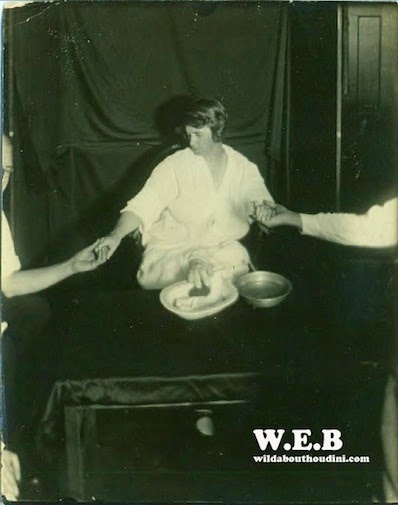Continuing my examination of books about Houdini using images and insights from my own collection.
 |
| First hardcover edition (1950). |
When discussing important Houdini biographies, it's easy to overlook
The Great Houdini, Magician Extraordinary by Beryl Williams and Samuel Epstein. That's because this 1950 book was geared to young readers. But I consider it "the gateway biography" because it not only "hooked" many young people on Houdini, it also ushered in the modern era of Houdini study by being the first book written for a generation that hadn't known the magician in life. This was the book that would tell the story of the legend, the immortal Houdini, which is the man we still study today. It also includes a nice forward by Walter B. Gibson.
While
The Great Houdini did repeat some of the mythology of
Kellock -- and even contributed some fresh mythology of it's own (young Ehrich learning magic from a magician named "Merlin"?) -- it also broke new ground. It was in this book that Martin Beck's contribution to Houdini's career was first recognized. And while this biography doesn't identify Bess as a fellow performer, it doesn't repeat the full acid on the dress fable from Kellock. Instead, it simply states that Houdini and Bess met and were married in Coney Island, which is true. Also absent is the infamous trapped under the ice story.
Unlike other books in this series, I can't confidently tell the story of
The Great Houdini's publication history, because there are just too many editions of this book in existence and it gets a little confusing when we get into the Scholastic paperbacks, as you will soon see. But I can share what I have in my collection and maybe others can fill in the gaps in the Comments section. So here we go.
The Great Houdini, Magician Extraordinary was first released in hardcover by Julian Messner in March 1950. A second edition was published in July 1950. A later hardcover edition had a curious feature. While the dust jacket art matched the first edition (apart from slightly different title treatment), under the jacket on the front board was a similar illustration, but with an image of Houdini as an older man. I'm not sure if this older Houdini ever made it onto a dust jacket, but I really like the idea of two versions of Houdini on the same book.
 |
| Presto! Remove the dust jacket and young Houdini becomes old Houdini. |
There are numerous library editions that used portions of the dust jacket artwork on their front boards. There was also a 1956 "Hall of Fame Series for Boys and Girls" which bound
The Great Houdini with
The Ringlings: Wizards of the Circus by Alvin F. Harlow. I have never seen one of these Hall of Fame editions with a dust jacket, so I'm assuinmg it was published without. A UK hardcover edition was published in 1971 by Bailey Bros. & Swinfen with original dust jacket artwork.
 |
| Typical library binding (left) and the UK hardcover from Bailey (right). |
The Great Houdini was first released in paperback by Pocket Book, Jr. in February 1951 with dramatic cover art showing Houdini in chains underwater. A nicely illustrated summation of the Houdini story is on the back. The paperback dropped the subtitle
Magician Extraordinary from the cover, and added illustrations by Louis Glanzman throughout.
 |
| First paperback edition from Pocket Book Jr. (1951). |
In the 1960s the
Scholastic Book Company made
The Great Houdini available to schools through their unique network of mail order book clubs, and here's where things get a little confusing. As far as I can tell, the first Scholastic edition was first published as TK 76 in an edition that was somewhat taller than their later paperbacks. That edition used new cover artwork showing Houdini in chains (
the famous pose).
When the Scholastic edition shrank down into the more familiar size, it lost the letter "K" and became T-76. Or could it be that the taller TK 76 was for retail and shorter T-76 was for schools? Just to add to the mystery, in my collection TK-76 is a second edition (no date), while my T-76 is a 14th printing from January 1971. But I also have Scholastic paperbacks dated 1965 with the original Pocket Jr. artwork that I recall seeing in schools and for sale in magic stores into the early '80s. So which cover came first on the Scholastics? I really don't know.
 |
| The two differently sized early Scholastic editions. |
T-76 was a perennial book club selection and a permanent featue in many school libraries and classrooms for decades. For many, this was their first encounter with Houdini. (Recently a friend's wife told me she vaguely remembered reading a Houdini book in grade school, and she was thrilled when I showed her a copy of T-76 -- that was it!) Scholastic's
The Great Houdini T-76 finally went out of print, I believe, sometime in the 1980s. Although for all I know, there could still be old copies on grade school classroom shelves to this day. I hope so.
The Great Houdini was last published in 1984 as a special hardcover edition limited to 80 copies by Amereon House. This edition contains all the Louis Glanzman illustrations from the paperback, the only hardcover to do so. It was a nice end and a fitting tribute to the great gateway biography.
 |
| A later (?) Scholastic edition and the Amereon special edition hardcover. |
Also enjoy:
















































